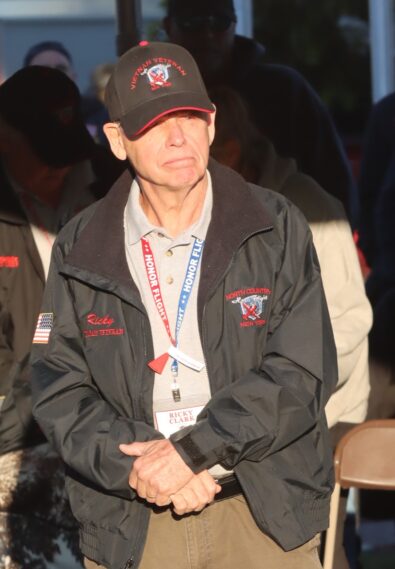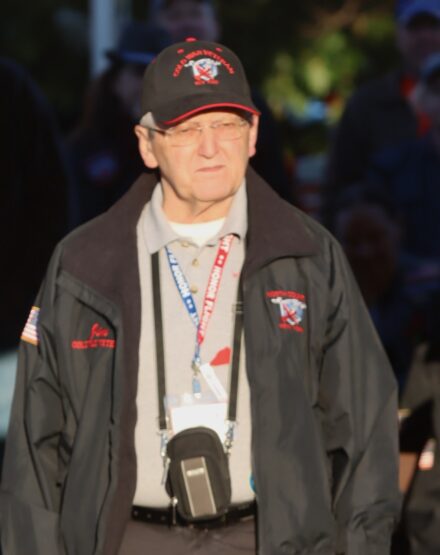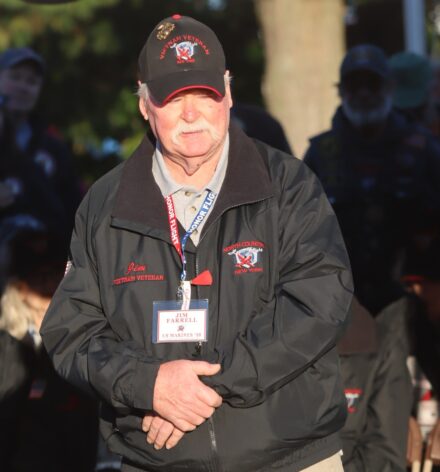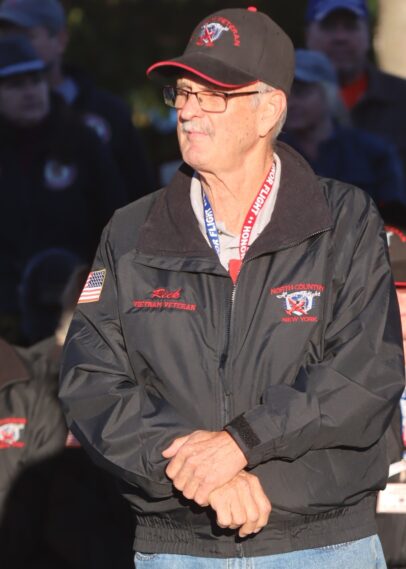Oct. 5, 2024 North Country Honor Flight 59 Veteran Biographies
 (All photos by David Brown)
(All photos by David Brown)
Richard Barnier, U.S. Army, 1949-1953 – Korean
Richard enlisted and had basic training at Fort Dix. Starting as a paratrooper, Richard changed to driving a tank and became a tank commander. During an amphibious operation, the timing of high tide was crucial for the successful landing of UN Forces, which needed a significant landing with a wave-like effect on the battlefront. On a boat, Richard saw General Douglas MacArthur. Richard discussed a memory that bothers him to this day. Driving through town, an enemy was camouflaged, and all hell broke loose. The Lieutenant ordered Richard, who was driving the tank, to run over a North Korean soldier, which still bothers Richard. Richard was leader of a Battalion driving a tank, the enemy fired and destroyed the tank in front of his. 94-year-old Richard Barnier
 Ricky Clark, U.S. Navy, 1966-1969 – Vietnam
Ricky Clark, U.S. Navy, 1966-1969 – Vietnam
Ricky enlisted and had basic training at Great Lakes Naval Station. On sea duty, Ricky, a deck aid, worked in the engine room. With a bucket, Ricky would bilge dive, lift deck plates up, degrease them with rags, and be careful not to touch the hot pipes. Ricky said they saw conflict off the coast of Vietnam. Ricky was a night hookman on a replenishing ship. Two ships ran side-by-side at synchronized speeds and courses as pallets stacked 5 feet high carrying hundreds of pounds of supplies traveled across cables from one ship to another. Ricky enjoyed seeing Japan, Hong Kong, and the Philippines.
 James DeLucas, U.S. Air Force, 1971-1995 – Cold War
James DeLucas, U.S. Air Force, 1971-1995 – Cold War
Jim had ROTC at MIT.At Eglin Air Force Base, Jim’s residency was in Family Practice. Sent to Plattsburgh Air Force Base, Jim was Chief of Family Practice. Jim’s 2nd residency was in Aerospace Medicine and a Master’s in Public Health. After a year in Korea, Jim returned to Plattsburgh, practiced medicine, and was the last hospital commander at the closing ceremony. In an F-16, Jim felt he was shot out of a cannon. After losing the Challenger space shuttle, Jim was the first to test seating and parachute weight as an escape system. His brother blasted off on Columbia in the very seat Jim tested. Jim served 24 years in military service.
 John DeZali, U.S. Air Force, 1967-1969 – Vietnam
John DeZali, U.S. Air Force, 1967-1969 – Vietnam
John had basic training at Lackland Air Force Base and became an Air Crew Survival Specialist. John kept the parachutes, survival kits, and helmets clean and in working condition. Once, a General came in and asked John to clean and check out his helmet, resulting in John receiving Airman of the Month.As a reward, John rode in a KC-135 from Maine to California and back to visit family. The military asked John to participate with the U.S. Air Force bobsled team. For two years, John was on the 2-man and 4-man bobsled teams, receiving medals on the 4-man team. They enjoyed beating the Navy bobsled team.
 James Farrell, U.S. Marine Corps, 1963-1967 – Vietnam
James Farrell, U.S. Marine Corps, 1963-1967 – Vietnam
Jim enlisted and had basic training at Parris Island. At Camp Geiger and Camp Lejeune, Jim had AIT training with the 3rd Infantry Division. Back from Vietnam, Jim had motor transport in Okinawa with the 3rd Battalion, 2nd, 3rd, 4th, and 5th Marine Divisions at the beach, loading and unloading ammo on the ships. Re-enlisting, Jim spent two years at Portsmouth Naval Shipyard delivering flags to the fallen at military funerals and serving as an Honor Guard. Jim recalls a day in Okinawa, drinking whiskey and an entire bottle of champagne, jumping into a pool, fully clothed.
 Bruce Finley, U.S. Air Force, 1969-1973 – Vietnam
Bruce Finley, U.S. Air Force, 1969-1973 – Vietnam
Bruce had basic training at Lackland Air Force Base and AIT in building maintenance at Shepard Air Force Base. Deployed to Vietnam, Bruce landed in Cam Rahn Bay, then Danang with the Red Horse Squadron. Bruce was the foreman on the painting crew who worked well with the civilian Vietnamese. At Monkey Mountain, Bruce’s highlight was the Bob Hope show, which featured Sammy Davis, Jr. and Ann Margaret. After 51 years, Bruce and his closest buddy, Bill Bennett, reunited. Bruce and Bill were under a rocket attack, hurrying to grab their helmets and vests, they collided running out of the tent. Bruce and Bill shared many memories.
 Robert Fish, U.S. Army, 1960-1966 – Vietnam, U.S. Army Reserves, 1976-2002
Robert Fish, U.S. Army, 1960-1966 – Vietnam, U.S. Army Reserves, 1976-2002
Bob enlisted, had basic training at Fort Dix, was a combat engineer and fixed trucks. In Germany, Bob and his buddies were drinking and playing poker. Receiving notice they were flying out, they gave all the money to the bartender’s girlfriend. Bob got along with everyone and enjoyed trips to Holland and Paris. Bob joined an MP Unit with the Vermont Army Reserves. Bob left Vermont to reduce travel and was a Chief ammunition inspector of Bullets and Missiles. Bob received orders to Desert Storm. Bob spent 32 years in military service and 35 years with the New York State Police.
 Richard Fournia, U.S. Army, 1972-1975 – Vietnam
Richard Fournia, U.S. Army, 1972-1975 – Vietnam
Rick enlisted and had basic training at Fort Dix and AIT with the 25th Infantry Division. Rick trained with the Infantry Platoon with the Australian Army and in South Korea. Rick served with two friends in Hawaii in the 1st Battalion, 19th Infantry. Sent to Germany, Rick was with the 1st Armored Personnel Carrier anti-tank missiles. Rick said he would do it all over again. Rick and two other dedicated friends, James Farrell and Todd Perry, also on today’s flight, have supported the American Legion Post 1618 in Saranac for 22 years. Rick’s dad, Clarence, flew on Honor Flight #34
Louis Hanlon, U.S. Army, 1968-1971 – Vietnam
Louis enlisted and had basic training at Fort Bragg and AIT training in artillery and cannoneer at Fort Sill. In Vietnam, Lou pushed projectiles into cannons to prepare for fire, taking the shells out and getting ready for the next. Lou was a forward observer with Company A, 505th Parachute Infantry Regiment. A radio operator, Lou, pre-plotted positions and gave 8-digit grid coordinates, inputting data to send information to guns adjusting fire. Troops were sent as water buffalo tripped flares, letting the enemy know where they were. Ninety minutes later, they were hit by enemy fire. Lou saved his Commander’s life as the fire was coming in.
Lawrence LaBombard, U.S. Army, 1958-1960 – Korean
Lawrence was working at Rochester State Hospital when he got his draft letter. Lawrence had basic training at Fort Jackson, and as they marched, they watched Elvis Presley get a haircut. Lawrence was sent to a missile base in Rhode Island. Lawrence had top-secret clearance. Lawrence was scared the first time he drove a combat truck through Boston carrying live warhead missiles. Lawrence guarded the missiles on guard duty, assuring no one came on to the base.
On KP duty, Lawrence saw a piece of cardboard, he picked it up and found a live grenade with the pin out. Putting it back down, Lawrence called the Sergeant, and they moved the live grenade to another location. Lawrence did not like flying to Korea, and he had not been on a plane since 1958. 89-year-old Lawrence LaBombard
 Philip Newton, U.S. Air Force, 1965-1968 – Vietnam
Philip Newton, U.S. Air Force, 1965-1968 – Vietnam
Phil enlisted and had basic training at Lackland Air Force Base. Phil was deployed to Tuy Hoa, Vietnam, during the Tet Offense. Phil was Security Police with the 31st Squadron Tactical Fighter Wing. Phil, who was doing law enforcement at the gate, also rode patrol escorting Vietnamese in and out of town. On MP duty, Phil did gate checks. Brick ones were replacing old wooden gates. Women (Mama-sans) tore down the gates with crowbars. Pointing and yelling at each other, they grabbed big mice, which was a delicacy. Phil said the Air Force took good care of the troops.
 Todd Perry, U.S. Army, Desert Storm
Todd Perry, U.S. Army, Desert Storm
With a delayed enlistment, Todd had basic training at Fort Jackson and AIT at Fort Leonard Wood in a specialized program for truck driving. When he signed the papers, Todd knew it was his duty to go to Desert Storm. Todd drove trucks and was a heavy vehicle mechanic. In Germany, Todd was part of running ammunition and multiple launch rocket systems loaded on rail beds and shipped out. Todd has no regrets, as he learned and saw a lot. They had a job to do, and they did it. Todd misses the camaraderie.
 Ricky Roberts, U.S. Navy, 1971-1974 – Vietnam
Ricky Roberts, U.S. Navy, 1971-1974 – Vietnam
At 18, Ricky had basic training at Great Lakes Naval Station. He became a Communications Technician and cleared Top Secret Crypto.On a prop plane Ricky and four others surrounded by mail bags, scared, a guy said, ‘we’re going to land on that’, an aircraft carrier with such force it crashed the doors open. Ricky received Morse Code from the North Vietnamese, and he broke the codes within 30 minutes. In the Gulf of Tonkin, Ricky served on the USS Coral Sea (CV-43) and USS America (CV-66) with a good crew working seven days a week, 12 hours on, 12 hours off
 Edward Saunders, U.S. Air Force, 1975-1995 – Desert Storm
Edward Saunders, U.S. Air Force, 1975-1995 – Desert Storm
At Lackland and Chanute Air Force Bases, Ed trained in aircraft maintenance. Ed flew on the KC-135 as an assistant crew chief and was selected for the bomb navigation competition. Ed’s boss expected him to perform at a high level. They didn’t win the Saunders Trophy. At Ellsworth Air Force Base, they flew a mission orbiting North and South Dakota, Wyoming, and Nebraska every Friday with a First Star General and other officers aboard in case a button had to be pushed to launch missiles. Ordered to Plattsburgh Air Force Base, Ed attended the first class of the Strategic Air Command. Ed served our country for 20 years.
Posted: October 6th, 2024 under General News.
